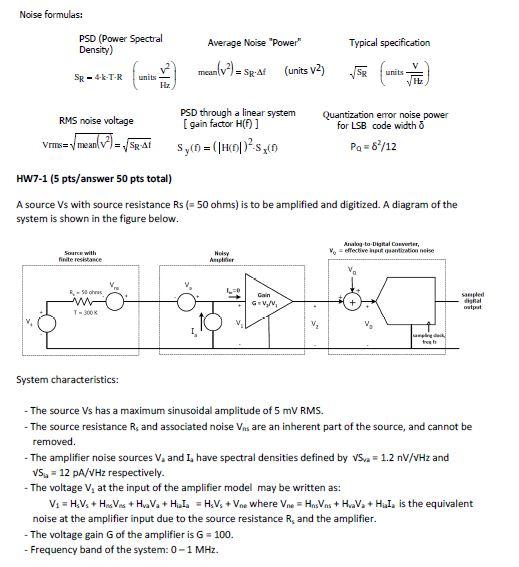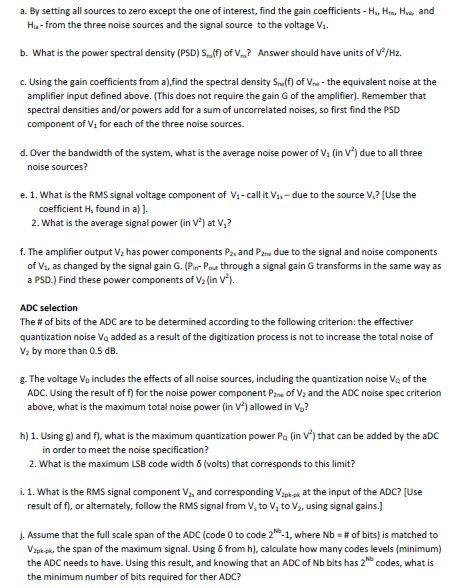Answered step by step
Verified Expert Solution
Question
1 Approved Answer
Noise formulas: PSD (Power Spectral Density) SR - 4-k-T-R RMS noise voltage Vrms=mean()=SR-At Source with finite resistance R - 50 ohras T-300K units V


Noise formulas: PSD (Power Spectral Density) SR - 4-k-T-R RMS noise voltage Vrms=mean()=SR-At Source with finite resistance R - 50 ohras T-300K units V System characteristics: Hz. Average Noise "Power" (v) = s mean = Sg.Af PSD through a linear system [gain factor H(f)] Sy(0) = (|HD|) S(0) HW7-1 (5 pts/answer 50 pts total) A source Vs with source resistance Rs (= 50 ohms) is to be amplified and digitized. A diagram of the system is shown in the figure below. (units V2) Noisy Amper Gain G=V/V Typical specification V units V Quantization error noise power for LSB code width o Pa = 8/12 Analog-to Digital Converter, V-effective input quantication nee sampling dek treb sampled digital output - The source Vs has a maximum sinusoidal amplitude of 5 mV RMS. - The source resistance R. and associated noise Vis are an inherent part of the source, and cannot be removed. -The amplifier noise sources V, and I, have spectral densities defined by VSva= 1.2 nV/VHz and VS = 12 pA/VHz respectively. - The voltage V at the input of the amplifier model may be written as: V = HVs + Has Ves + Hva Va + Hiala = HV +Vne where Ve HasVns + HaV + Hula is the equivalent noise at the amplifier input due to the source resistance R, and the amplifier. - The voltage gain G of the amplifier is G= 100. - Frequency band of the system: 0-1 MHz. a. By setting all sources to zero except the one of interest, find the gain coefficients - H., Hra, Hva, and Hu- from the three noise sources and the signal source to the voltage V. b. What is the power spectral density (PSD) S(f) of V? Answer should have units of V/Hz. c. Using the gain coefficients from a),find the spectral density Sm(f) of V- the equivalent noise at the amplifier input defined above. (This does not require the gain G of the amplifier). Remember that spectral densities and/or powers add for a sum of uncorrelated noises, so first find the PSD component of V for each of the three noise sources. d. Over the bandwidth of the system, what is the average noise power of V (in V) due to all three noise sources? e. 1. What is the RMS signal voltage component of V- call it V-due to the source V? [Use the coefficient H, found in a) ]. 2. What is the average signal power (in V) at V? f. The amplifier output V has power components P2. and Pane due to the signal and noise components of V, as changed by the signal gain G. (Pin Puut through a signal gain G transforms in the same way as a PSD.) Find these power components of V (in V). ADC selection The # of bits of the ADC are to be determined according to the following criterion: the effectiver quantization noise Va added as a result of the digitization process is not to increase the total noise of V by more than 0.5 dB. g. The voltage V, includes the effects of all noise sources, including the quantization noise Vo of the ADC. Using the result of f) for the noise power component Pane of V and the ADC noise spec criterion above, what is the maximum total noise power (in V) allowed in V? h) 1. Using g) and f), what is the maximum quantization power Pu (in V) that can be added by the aDC in order to meet the noise specification? 2. What is the maximum LSB code width 5 (volts) that corresponds to this limit? i. 1. What is the RMS signal component V, and corresponding Vapk-p at the input of the ADC? [Use result of f), or alternately, follow the RMS signal from V, to V to V, using signal gains.] j. Assume that the full scale span of the ADC (code 0 to code 2-1, where Nb = # of bits) is matched to Vapk-pik, the span of the maximum signal. Using & from h), calculate how many codes levels (minimum) the ADC needs to have. Using this result, and knowing that an ADC of Nb bits has 2 codes, what is the minimum number of bits required for ther ADC?
Step by Step Solution
★★★★★
3.44 Rating (151 Votes )
There are 3 Steps involved in it
Step: 1
a Gain coefficients from noise sources to V1 Hvs 1 signal passes directly through Hva 0 amp...
Get Instant Access to Expert-Tailored Solutions
See step-by-step solutions with expert insights and AI powered tools for academic success
Step: 2

Step: 3

Ace Your Homework with AI
Get the answers you need in no time with our AI-driven, step-by-step assistance
Get Started


